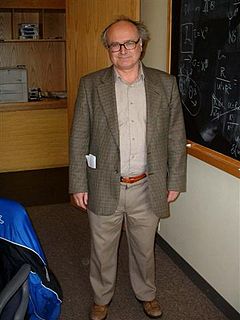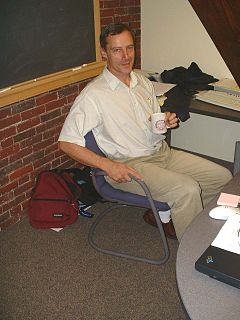Related Research Articles

Michael James Duff FRS, FRSA is a British theoretical physicist and pioneering theorist of supergravity who is the Principal of the Faculty of Physical Sciences and Abdus Salam Chair of Theoretical Physics at Imperial College London.

Nathan "Nati" Seiberg is an Israeli American theoretical physicist who works on quantum field theory and string theory. He is currently a professor at the Institute for Advanced Study in Princeton, New Jersey, United States.
In theoretical physics, a graviphoton or gravivector is a hypothetical particle which emerges as an excitation of the metric tensor in spacetime dimensions higher than four, as described in Kaluza–Klein theory. However, its crucial physical properties are analogous to a (massive) photon: it induces a "vector force", sometimes dubbed a "fifth force". The electromagnetic potential emerges from an extra component of the metric tensor , where the figure 5 labels an additional, fifth dimension.

Gary William Gibbons is a British theoretical physicist.
Savas Dimopoulos is a particle physicist at Stanford University. He worked at CERN from 1994 to 1997. Dimopoulos is well known for his work on constructing theories beyond the Standard Model.
Emil John Martinec is an American string theorist, a physics professor at the Enrico Fermi Institute at the University of Chicago, and director of the Kadanoff Center for Theoretical Physics. He was part of a group at Princeton University that developed heterotic string theory in 1985.
In theoretical physics, thermal quantum field theory or finite temperature field theory is a set of methods to calculate expectation values of physical observables of a quantum field theory at finite temperature.

Bernard Julia is a French theoretical physicist who has made contributions to the theory of supergravity. He graduated from Université Paris-Sud in 1978, and is directeur de recherche with the CNRS working at the École Normale Supérieure. In 1978, together with Eugène Cremmer and Joël Scherk, he constructed 11-dimensional supergravity. Shortly afterwards, Cremmer and Julia constructed the classical Lagrangian for four-dimensional N=8 supergravity by dimensional reduction from the 11-dimensional theory. Julia also studied spontaneous symmetry breaking and the Higgs mechanism in supergravity
Bruno Zumino was an Italian theoretical physicist and faculty member at the University of California, Berkeley. He obtained his DSc degree from the University of Rome in 1945.
The history of string theory spans several decades of intense research including two superstring revolutions. Through the combined efforts of many researchers, string theory has developed into a broad and varied subject with connections to quantum gravity, particle and condensed matter physics, cosmology, and pure mathematics.

Renata Elizaveta Kallosh is a theoretical physicist. She is a Professor of Physics at Stanford University, working there on supergravity, string theory and inflationary cosmology.
In quantum field theory, a Slavnov–Taylor identity is the non-Abelian generalisation of a Ward–Takahashi identity, which in turn is an identity between correlation functions that follows from the global or gauged symmetries of a theory, and which remains valid after renormalization. The identity was originally discovered by Gerard 't Hooft, and it is named after Andrei Slavnov and John C. Taylor who rephrased the identity to hold off the mass shell.
Black hole complementarity is a conjectured solution to the black hole information paradox, proposed by Leonard Susskind, Larus Thorlacius, and Gerard 't Hooft.

Gian Francesco Giudice is an Italian theoretical physicist working at CERN in particle physics and cosmology.
The Nielsen–Ninomiya theorem is a no-go theorem in physics, in particular in lattice gauge theory, concerning the possibility of defining a theory of chiral fermions on a lattice in even dimensions. The theorem can be stated as follows: let be the (Euclidean) action describing fermions on a regular lattice of even spacetime dimension with periodic boundary conditions, and suppose that S is local, hermitian and translation invariant; then the theory describes as many left-handed as right-handed states. Equivalently, the theorem implies that there are as many states of chirality +1 as of chirality −1. The proof of the theorem relies on the Poincaré–Hopf theorem or on similar results in algebraic topology.

Riccardo Barbieri is an Italian theoretical physicist and a professor at the Scuola Normale Superiore di Pisa. He has written more than two hundred research papers in the field of theoretical elementary particle physics, and has been particularly influential in physics beyond the Standard Model.

Riccardo Rattazzi is an Italian theoretical physicist and a professor at the École Polytechnique Fédérale de Lausanne. His main research interests are in physics beyond the Standard Model and in cosmology.
Peter Christopher West, born on 4 December 1951, is a British theoretical physicist at King's College, London and a fellow of the Royal Society.
Martin B. Einhorn is an American theoretical physicist.
Hermann Nicolai is a German theoretical physicist and director emeritus at the Max Planck Institute for Gravitational Physics in Potsdam-Golm.
References
- ↑ Gibbons, G. W; Hawking, S. W; Perry, M. J (1978). "Path Integrals and the Indefiniteness of the Gravitational Action". Nucl. Phys. B 138 (1): 141–150. Bibcode:1978NuPhB.138..141G. doi:10.1016/0550-3213(78)90161-X.
- ↑ Myers, Robert C.; Perry, M. J (1986). "Black Holes in Higher Dimensional Space-Times". Annals of Physics. 172 (2): 304–347. Bibcode:1986AnPhy.172..304M. doi:10.1016/0003-4916(86)90186-7.
- ↑ David J. Gross, Malcolm J. Perry (1983). "Magnetic Monopoles in Kaluza-Klein Theories". Nucl. Phys. B. 226 (1): 29–48. Bibcode:1983NuPhB.226...29G. doi:10.1016/0550-3213(83)90462-5.
- ↑ Curtis Callan Jr., Emil J. Martinec, Daniel Friedan, Malcolm J. Perry (1985). "Strings in background fields". Nucl. Phys. B. 262 (4): 593–609. Bibcode:1985NuPhB.262..593C. doi:10.1016/0550-3213(85)90506-1.
{{cite journal}}: CS1 maint: multiple names: authors list (link) - ↑ David Berman; Malcolm J. Perry (2011). "Generalized geometry and M theory". JHEP. 1106 (6): 74. arXiv: 1008.1763 . Bibcode:2011JHEP...06..074B. doi:10.1007/JHEP06(2011)074.